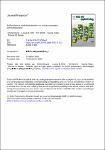Artificial light at night alters predation on colour-polymorphic camouflaged prey
| dc.contributor.author | Moyse, E | |
| dc.contributor.author | Firth, L | |
| dc.contributor.author | Smyth, T | |
| dc.contributor.author | Tidau, S | |
| dc.contributor.author | Davies, T | |
| dc.date.accessioned | 2023-11-15T10:57:26Z | |
| dc.date.available | 2023-11-15T10:57:26Z | |
| dc.date.issued | 2023-12 | |
| dc.identifier.issn | 1439-1791 | |
| dc.identifier.issn | 1618-0089 | |
| dc.identifier.uri | https://pearl.plymouth.ac.uk/handle/10026.1/21646 | |
| dc.description.abstract |
Artificial light at night (ALAN) disrupts biological processes across taxa and at all levels of organisation. Despite growing interest in this globally pervasive sensory pollutant, its impact on colour-guided processes remains largely unexplored. This is especially concerning given the rapid transition in recent years away from narrow-spectrum lighting and towards broad-spectrum options such as white LEDs, which are rich in the short wavelengths of light to which many taxa are particularly sensitive. Camouflage is particularly likely to be disrupted by broader spectra of ALAN due to changes in conspicuousness in background matching prey, which may alter prey recognition in visually guided predators. We simulated natural intensities of moonlight with and without ALAN, using both broad-spectrum (‘white’) ALAN and ALAN filtered to remove the characteristic short (blue) wavelength peak of broad-spectrum LEDs to test whether filtering might mitigate their effects. We tested how exposure to these light treatments impacted predator-prey interactions, using the intertidal crab Carcinus maenas and contrasting colour morphs of the colour-polymorphic snail Littorina obtusata as a model system. Exposure to broad-spectrum ALAN reduced overall predation and reversed the pattern of colour-based prey selection observed under control conditions. Snails were 55% less likely to be attacked under broad-spectrum ALAN than in control conditions, with likelihood decreasing over 70% for yellow snails. Yellow snails were over 26% more likely to be attacked than brown ones under control conditions, but brown snails were over 40% more likely to be attacked than yellow ones under broad-spectrum ALAN. Exposure to filtered ALAN removed any significant colour-based difference in prey recognition. Our results demonstrate that spectral composition is a crucial aspect of ALAN as a sensory pollutant, capable of instigating profound changes in predator-prey interactions that could drive changes in population demography and increase morphological homogeneity in species that depend on colour polymorphism for camouflage. | |
| dc.format.extent | 88-93 | |
| dc.language | en | |
| dc.publisher | Elsevier | |
| dc.subject | Artificial light at night | |
| dc.subject | Artificial light spectra | |
| dc.subject | Light pollution | |
| dc.subject | Camouflage | |
| dc.subject | Colour polymorphism | |
| dc.subject | Visual ecology | |
| dc.subject | Global change | |
| dc.subject | Species interactions | |
| dc.subject | Invertebrate | |
| dc.title | Artificial light at night alters predation on colour-polymorphic camouflaged prey | |
| dc.type | journal-article | |
| dc.type | Article | |
| plymouth.volume | 73 | |
| plymouth.publication-status | Published | |
| plymouth.journal | Basic and Applied Ecology | |
| dc.identifier.doi | 10.1016/j.baae.2023.11.002 | |
| plymouth.organisational-group | |Plymouth | |
| plymouth.organisational-group | |Plymouth|Faculty of Science and Engineering | |
| plymouth.organisational-group | |Plymouth|Faculty of Science and Engineering|School of Biological and Marine Sciences | |
| plymouth.organisational-group | |Plymouth|REF 2021 Researchers by UoA | |
| plymouth.organisational-group | |Plymouth|Users by role | |
| plymouth.organisational-group | |Plymouth|Users by role|Academics | |
| plymouth.organisational-group | |Plymouth|REF 2021 Researchers by UoA|UoA07 Earth Systems and Environmental Sciences | |
| plymouth.organisational-group | |Plymouth|Users by role|Researchers in ResearchFish submission | |
| plymouth.organisational-group | |Plymouth|REF 2028 Researchers by UoA | |
| plymouth.organisational-group | |Plymouth|REF 2028 Researchers by UoA|UoA07 Earth Systems and Environmental Sciences | |
| dcterms.dateAccepted | 2023-11-11 | |
| dc.date.updated | 2023-11-15T10:57:26Z | |
| dc.rights.embargodate | 2023-11-16 | |
| dc.identifier.eissn | 1618-0089 | |
| rioxxterms.versionofrecord | 10.1016/j.baae.2023.11.002 |


